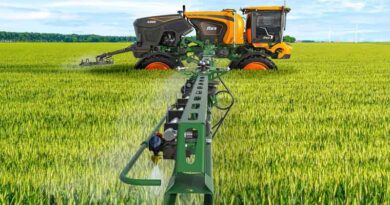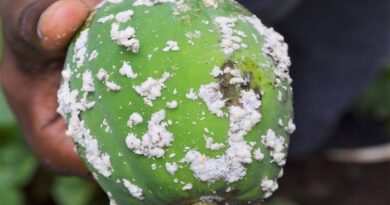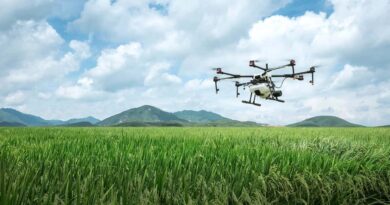Drones in India: How are Indian farmers responding to the use of drones on field
Guest Author: Amandeep Panwar, Director & Co-founder, BharatRohan – Agri-Tech Drone Startup
13 March 2024, New Delhi: The market size of agriculture drones in India is a dynamic and growing sector with significant potential for expansion. The Indian agriculture drone market is experiencing rapid growth, fueled by technological advancements, government support, and the increasing adoption of precision farming techniques. The Indian agriculture drone market was valued at approximately USD 122 million in 2021 and is projected to reach around USD 1.32 billion by 2028, growing at a CAGR of approximately 47.8% between 2022 and 2028. This growth is indicative of a robust increase in the penetration of drones in agricultural practices across the country.

The surge in the agricultural drone market in India is further propelled by the need to enhance crop yields and efficiency in response to the growing food demand from a burgeoning population. Initiatives for rural digitization and the emphasis on sustainable agricultural practices have also played pivotal roles in fostering this growth. Moreover, collaborations between tech companies and agricultural sectors to develop farmer-centric drone solutions are amplifying the market’s expansion. The integration of drones with advanced imaging technologies and data analytics is revolutionizing traditional farming methods, paving the way for a new era of precision agriculture in India. This evolution signifies a transformative shift towards more technologically integrated and data-driven farming practices, setting a benchmark for innovation in agriculture globally.
Increasing Penetration of Drones in India’s Agriculture Sector
The adoption of drones in agriculture in India has significantly enhanced various farming practices:
● Soil and Field Analysis: Drones provide accurate 3-D maps for early soil analysis, aiding in planning seed planting patterns and managing irrigation and nitrogen levels.
● Crop Monitoring: Drones overcome the challenges of monitoring vast fields and unpredictable weather by providing precise development animations of crops, leading to better crop management.
●Irrigation: Equipped with advanced sensors, drones identify dry areas for efficient water allocation, aiding in vegetation index calculation and health assessment.
● Health Assessment: By scanning crops with visible and near-infrared light, drones can detect plant health and potential infections, allowing for rapid response.
● Mid-field Weed Identification: Drones create weed maps using NDVI sensor data, helping farmers distinguish between weeds and crops.
● Crop Insurance: Drones facilitate quick assessment of cultivated land, damage from natural disasters, and fraud detection, benefiting insurers and farmers alike
● Data Analytics Integration: The data collected by drones is increasingly being integrated with AI and machine learning algorithms to predict crop yields, detect disease patterns more accurately, and offer insights that can lead to more informed agricultural decisions.
● Partnerships and Collaborations: There’s a growing trend of partnerships between drone technology providers, agricultural companies, research institutions, and the government to pilot and scale innovative drone applications. These collaborations aim to tailor drone technologies to fit local farming needs and constraints, ensuring higher adoption rates.
● Government Initiatives and Support: The Indian government has been actively promoting the use of drones in agriculture through various initiatives and regulatory reforms. The Ministry of Civil Aviation and the Directorate General of Civil Aviation (DGCA) have facilitated drone operations by granting permissions via the conditional exemption route.
How are drones catering to the needs of small farmers
Drones are revolutionizing the way smallholder farmers manage their crops by providing them with affordable, precision agriculture tools. These unmanned aerial vehicles (UAVs) enable farmers to access detailed insights about their fields. Drones equipped with advanced sensors can monitor crop health, identify pest infestations, and assess water needs. This level of detail allows for targeted interventions, reducing the need for broad-spectrum pesticide application and optimizing water usage.
The cost of operating drones for agricultural purposes is designed to be affordable for small farmers. Typically, the service charge is around Rs. 399 per cropping season per acre. This cost includes the collection and analysis of data, which is then used to advise farmers on the best practices for their specific situation. Drones can cover large areas of land quickly, saving time and labor costs. They provide regular, timely data that can help in the early detection of potential issues before they become major problems, thus reducing the risk of crop failure.
Farmers’ Response and Satisfaction with Drone Crop Monitoring
The response from farmers to drone-based crop monitoring has been overwhelmingly positive. For instance, mint farmers from Barabanki, Uttar Pradesh who have used BharatRohan’s advisory services reported savings of Rs. 3600 per acre by optimizing agri-inputs. They also saw an increase in yield from 50 kg to 70 kg per acre, leading to an additional income of approximately Rs. 20,000 per acre. This indicates a significant improvement in profitability and sustainability for farmers employing drone technology in their agricultural practices.
Role of Drones in Shaping the Future of Agricultural Labor
Drones are revolutionizing agriculture by improving efficiency and precision. However, it’s unlikely they will completely replace human labor in the near future. Critical farming tasks, such as pruning and harvesting delicate crops, require human judgment and manual skills beyond current drone capabilities. Despite rapid technological advancements, drones face limitations in battery life, payload capacity, and executing tasks needing human dexterity and decision-making. Thus, drones are expected to complement rather than replace human labor, excelling in data collection, monitoring, and specific application tasks. Nonetheless, human oversight and intervention remain essential for strategic decision-making and handling complex agricultural activities.
Furthermore, the integration of drones into agriculture introduces new job categories and demands for skills, particularly in drone operation, data analysis, and precision agriculture planning. This shift suggests a transformation rather than a replacement of labor, where the workforce needs to adapt to new technologies and roles.
Also Read: Coromandel’s Gromor Drive Crosses 16,000+ acres of Drone-led Spraying
(For Latest Agriculture News & Updates, follow Krishak Jagat on Google News)















